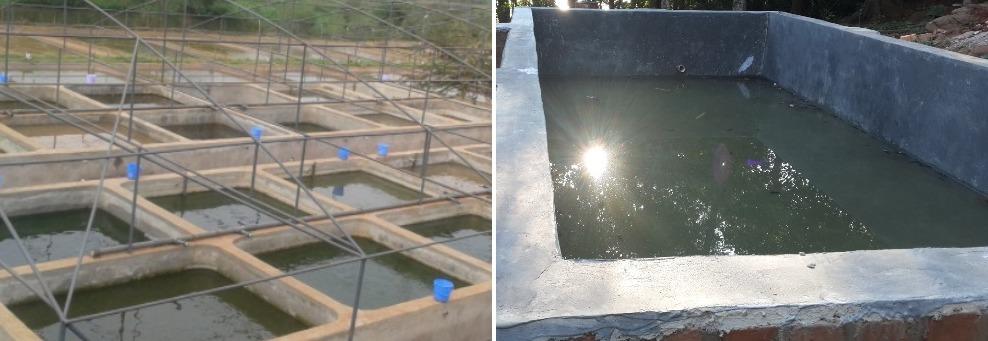- This topic is empty.
- AuthorPosts
- Aprili 8, 2025 at 5:37 mu #623879

Designing and managing concrete ponds is a critical aspect of achieving optimal fish production in aquaculture. Concrete ponds offer numerous advantages over other pond materials, including durability, better water quality management, and easier maintenance.
However, to maximize these benefits and ensure a successful fish farming operation, careful planning and effective management are essential. By considering the design elements, water quality, aeration systems, and monitoring practices, farmers can create an environment that promotes healthy fish growth, reduces risks, and enhances productivity.
Designing and managing concrete ponds effectively not only improves farm profitability but also supports sustainable and responsible aquaculture practices.
1. Key Design Considerations for Concrete Ponds
The design of a concrete pond plays a significant role in determining the success of fish production. When designing concrete ponds, factors such as size, depth, shape, and location must be carefully considered. The pond should be large enough to provide adequate space for the fish to grow, while the depth should allow for optimal water circulation and oxygen distribution.
The shape of the pond should facilitate efficient water flow and minimize areas where waste can accumulate. Additionally, the location of the pond should take into account local climate conditions, access to water sources, and the potential for environmental risks. Proper design ensures that the pond can support healthy fish populations and minimize the need for frequent adjustments or repairs.
2. Water Quality Management Systems
Maintaining high water quality is one of the most important factors in optimizing fish production. Concrete ponds are ideal for water quality management because they offer greater control over water conditions compared to earthen ponds. Farmers should install effective filtration systems that remove waste products, organic matter, and toxins from the water.
Aeration systems are essential for maintaining dissolved oxygen levels, which are critical for fish health and growth. Proper water circulation is also vital to ensure that the water does not become stagnant and that all areas of the pond receive adequate oxygenation.
Regular water testing is necessary to monitor parameters such as pH, ammonia levels, and temperature, allowing farmers to make adjustments as needed to maintain optimal conditions for fish.
3. Optimizing Fish Stocking Density
Stocking density is an important factor in managing concrete ponds for optimal fish production. Overstocking can lead to stress, disease outbreaks, and competition for food and oxygen, which can ultimately reduce growth rates and increase mortality.
On the other hand, understocking may not maximize the production potential of the pond. The ideal stocking density varies based on the species of fish being farmed, the size of the pond, and the water quality. By calculating the appropriate stocking density, farmers can ensure that fish have enough space to grow without overcrowding, leading to healthier fish and higher production yields.
Proper management of stocking density also reduces the risk of water contamination and helps maintain balanced ecosystems within the pond.
4. Regular Maintenance and Monitoring Practices
To ensure that concrete ponds continue to support optimal fish production, regular maintenance and monitoring practices are necessary. Concrete ponds are durable but still require periodic inspection for signs of wear, cracks, or leaks. Any damage should be repaired promptly to prevent water loss or contamination.
In addition to structural maintenance, farmers should regularly clean the pond to remove accumulated debris, uneaten feed, and fish waste. Monitoring systems, such as automated sensors for water temperature, oxygen levels, and pH, can provide real-time data to help farmers make quick decisions regarding pond management.
Maintaining detailed records of water quality, fish health, and pond conditions ensures that farmers can identify and address any issues early, preventing costly problems in the future.
5. Implementing Sustainable Aquaculture Practices
Sustainable aquaculture practices are essential for long-term success and environmental responsibility in fish farming. Concrete ponds support sustainability by reducing water waste and minimizing environmental impacts, but farmers must also implement strategies to ensure resource efficiency and protect local ecosystems.
Using closed-loop water systems can reduce water consumption by recycling and filtering water within the pond. Additionally, proper waste management practices, such as using organic matter as fertilizer or converting waste into biogas, can minimize the environmental footprint of the farm.
Adopting integrated pest management (IPM) strategies, controlling the use of chemicals, and promoting fish health through good biosecurity practices also contribute to sustainability. By incorporating these practices into pond management, farmers can produce fish efficiently while protecting the environment.
In conclusion, designing and managing concrete ponds for optimal fish production requires careful planning, attention to detail, and effective management practices. From the initial design and water quality management to stocking density, maintenance, and sustainability practices, each aspect of pond management contributes to the overall success of the farm.
Concrete ponds offer a durable, efficient, and sustainable solution for aquaculture, enabling farmers to produce healthy fish while minimizing environmental impact. By implementing best practices and continually monitoring pond conditions, farmers can achieve high production yields, improve farm profitability, and ensure the long-term viability of their aquaculture operations.
Read Also: Investing in Durable Concrete Ponds for Sustainable Aquaculture
- AuthorPosts
- You must be logged in to reply to this topic.

